20th century swiss sculptor, painter, draftsman and printmaker. The works of Alberto Giacometti were influenced by different artistic styles such as Surrealism, Cubism and other Philosophy sources. At the center of his creations the human condition played an important role.
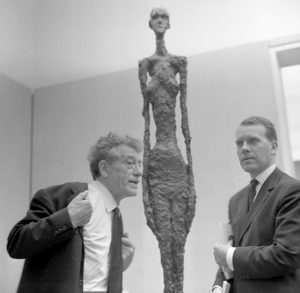
Image source:https://en.wikipedia.org/wiki/Alberto_Giacometti
Becoming a master
Alberto Giacometti spent his infancy in the village of Stampa, to which he returned very often until his death. He grew up among two brothers, who also had a talent for the arts. One became an architect, the other served as Giacometti’s model and assistant.
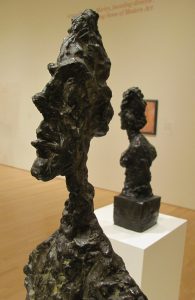

Image source: https://www.flickr.com/photos/rocor/5088075937
Image source: https://search.creativecommons.org/photos/a8bc5083-25c9-47d1-87ef-2ca875c3b00c by y.caradec
Giacometti left his school in Schiers in 1919 and went to Geneva where he attended art classes during winter time. During the summer he travelled in Rome and Florence and studied ancient Egyptian art collections. Some pieces with their particular steady gazes proved to have a great impact on his future art works.
Between 1922 and 1925 Alberto studied in Paris at the “Académie de la Grande-Chaumière”. His teacher Émile-Antoine Bourdelle helped him to develop his own style, some features were related to Cubist sculptures by Raymond Duchamp-Villon and Alexander Archipenko and also to the Post-Cubist sculptures by Jacques Lipchitz and Henri Laurens. For example In “Torso” (1925) Giacometti mixed the Classical tradition with the avant-garde style and deconstructed the human body to a group of different geometric shapes.
Imaginary reality
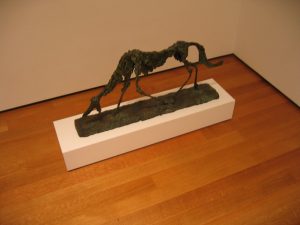
One of several pieces by Alberto Giacometti
at the Museum of Modern Art, New York City
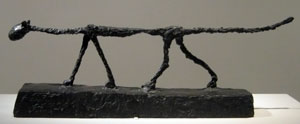
Image source: https://search.creativecommons.org/photos/e3904c45-e8be-43f9-90cc-2d33f86f0897
Image source: https://en.wikipedia.org/wiki/Alberto_Giacometti
Between 1938 and 1944 period his sculptures had a maximum height of seven centimeters. After World War II Giacometti designed his most famous sculptures: extremely slender and tall figurines which symbolized the human spirit, annihilated by the horrors of war. That sort of sculptures were subjects to his personal experience – something between an imaginary reality and physical space.
Info source: https://en.wikipedia.org/wiki/Alberto_Giacometti
His surrealistic influences gave up around 1935 in order to pursue a more thorough analysis of figurative compositions. Sometimes Giacometti wrote texts for exhibition and periodical catalogs . He also recorded memories and thoughts in his diaries and notebooks. The self-critical nature led him to develop great doubts about his artistic works and his ability to do justice to his own creative ideas. However at the same time this doubts acted as a substantial motivating force.
“Femmes de Venise”
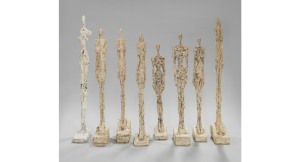
Image source: https://www.artsy.net/artwork/alberto-giacometti-women-of-venice-femmes-de-venise
In the 1950s Giacometti started to gain international acclamation: a lot of writers, critics, and philosophers recognized his skills as an incarnation of his generation. In this period the artist was focused on the representation of slender female nudes, with particular elegiac forms. These shapes emphasized the relationship between the gravity and body. For instance the “Femmes de Venise” for the French Pavilion. Giacometti created fifteen
bronze figures, sculpting clay over wire armatures. The “Femmes de Venise” are rendered with accurate and elegant language in order to speak about universal themes of life and death, light and darkness.
Out of categories

Image source: https://search.creativecommons.org/photos/7310526c-08a2-4687-95d3-3314fe8ba95a
The master died in 1966 of heart disease in Switzerland, and after some time his body was returned to the birthplace – Borgonovo, close to his parents. Alberto Giacometti didn’t have children and his wife Annette became the sole holder of property rights. She spent a lot of time trying to collect numerous authenticated works by his husband.
No doubt that Giacometti was an important player in the surrealism art movement, but in general it’s really not easy to assign any category to his work. Some art critics describe it as formalist, some else argue it is a kind of expressionist, Deleuze called it “blocs of sensation”. William Barrett in “Irrational Man” discusses about particular forms of figures that can reflect the philosophic views of modernism and existentialism.
Info source:
https://en.wikipedia.org/wiki/Alberto_Giacometti
https://www.britannica.com/biography/Alberto-Giacometti
https://gagosian.com/artists/alberto-giacometti/
https://www.hermitagemuseum.org/wps/portal/hermitage/what-s-on/temp_exh/1999_2013/hm4_1_206/?
lng=https://www.straight.com/arts/1256991/vancouver-art-gallery-sculpts-pleasing-portrait-alberto-giacometti
